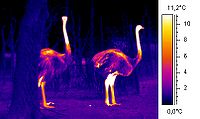
Photo from wikipedia
ABSTRACT The Darwinian fitness of mammals living in a rhythmic environment depends on endogenous daily (circadian) rhythms in behavior and physiology. Here, we discuss the mechanisms underlying the circadian regulation… Click to show full abstract
ABSTRACT The Darwinian fitness of mammals living in a rhythmic environment depends on endogenous daily (circadian) rhythms in behavior and physiology. Here, we discuss the mechanisms underlying the circadian regulation of physiology and behavior in mammals. We also review recent efforts to understand circadian flexibility, such as how the phase of activity and rest is altered depending on the encountered environment. We explain why shifting activity to the day is an adaptive strategy to cope with energetic challenges and show how this can reduce thermoregulatory costs. A framework is provided to make predictions about the optimal timing of activity and rest of non-model species for a wide range of habitats. This Review illustrates how the timing of daily rhythms is reciprocally linked to energy homeostasis, and it highlights the importance of this link in understanding daily rhythms in physiology and behavior. Summary: The daily temporal niche of animals is adaptive and depends on environmental and physiological context.
Journal Title: Journal of Experimental Biology
Year Published: 2017
Link to full text (if available)
Share on Social Media: Sign Up to like & get
recommendations!